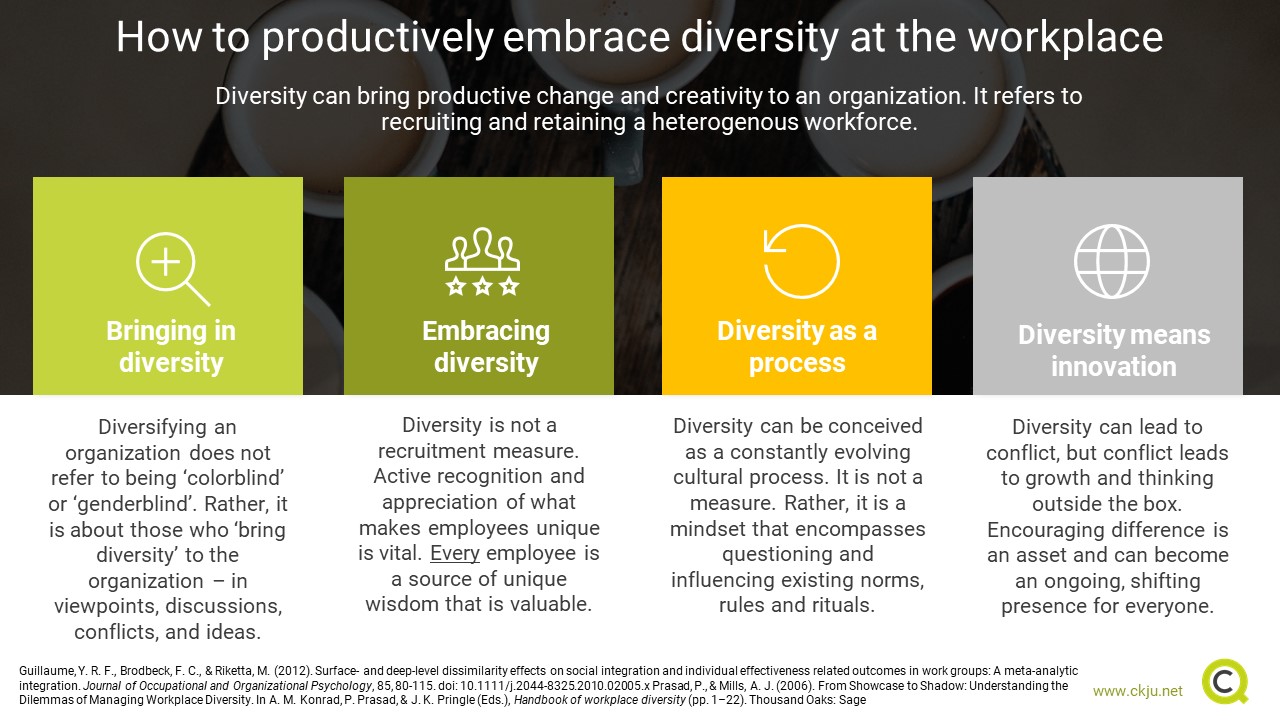- Blog
- Embracing diversity
Contents
- Diversity management is a means of recruiting and retaining heterogenous employees.
- Diversity sensitivity: a cottage industry selling a great deal, but not always delivering.
- Embracing diversity is a more dynamic, conflict-accepting approach that is becoming more popular.
- Working with diversity to increase innovation.
- References and further reading
While diversity can bring productive change and creativity to an organization, it is also frequently associated with difficulty and conflict (Guillaume, Brodbeck, & Riketta, 2012). Effectively harnessing the advantages of diversity requires embracing uniqueness and challenge, though many organizations have instead approached diversity as a commodity to secure and then diminish the negative impact of. This “paradox of diversity” is explored below.
Diversity management is a means of recruiting and retaining heterogenous employees.
While once simply a term used to describe a team’s composition (or lack of heterogeneity), diversity has shifted, becoming a feature of the workplace that organizations are encouraged to manage or even embrace. In the 80’s and 90’s, diversity management was one of the leading approaches, and entailed organizations systematically planning and committing to hire and retain employees from under-represented backgrounds (Thomas, 1992; Prasad & Mills, 2006). Rather than taking a “colorblind” or “genderblind” approach to hiring, organizations that managed diversity reached out to groups of people that were seen as “bringing diversity” to the organization.
This conscious approach has been successful, in that it is associated with increases in racial and gender diversity (Prasad & Mills, 2006). However, when attempts at increasing diversity ended at recruitment, organizations often observed increased conflict between employees, and between management and new hires (Skerry, 2002). Retention among more “diverse” hires is typically observed to be lower (Kaplan, Wiley, & Maertz, 2011); a striking contemporary example of this is the large numbers of women in tech who leave the industry following a negative workplace experience with sexism or harassment (Glass, Sassler, Levitte, & Michelmore, 2013). Achieving productive diversity, then, cannot end at the hiring phase.
Management skills newsletter
Join our monthly newsletter to receive management tips, tricks and insights directly into your inbox!
Diversity sensitivity: a cottage industry selling a great deal, but not always delivering.
Once employees from diverse background have been hired, organizations are encouraged by the managing diversity perspective to actively recognize and appreciate what makes their employees unique. However, in many organizations, the responsibility for this cultural appreciation and outreach has been taken on by consultants, training experts, and other individuals from outside of the organization. Diversity became, in some organizations, something to be managed through spending money on seminars, human resource textbooks, and training videos (Allen, 1991).
During the period that this was at its height (the late 1980s through the 1990s), organizational researchers often engaged in what Prasad and Mills (2006) called “distant cheerleading”: diversity was encouraged and lauded, but from a distance, with little hands-on support from either academics or in-organization management. Women, black people, and other under-represented groups often reported being on the receiving end of condescension or hostility, while white male employees reported increased resentment of their workplace’s hiring policies and diversity-centric workshops and training sessions. Diversity was often seen in organizations as a commodity to attain, rather than an ongoing process of change and acculturation.
Embracing diversity is a more dynamic, conflict-accepting approach that is becoming more popular.
The diversity management perspective, while still popular in many organizations, has slowly been challenged and superseded by the perspective that diversity should instead be embraced. According to the embracing diversity perspective, difference is an asset to be harnessed, but also a challenge to be worked with. Research in this area typically finds that diverse work groups are more creative, but also experience greater conflict (Guillaume, Brodbeck, & Riketta, 2012). Neither of these changes should be seen as negative.
Under this framework, it is expected that there will be increased conflict when an organization diversifies (DiTomaso, Post, & Parks-Yancy, 2007). Rather than papering over difficulty with sensitivity workshops lead by external diversity consultants, cultural change within the organization must occur (Glass et al, 2013). Organizations must be aware, when beginning to diversify, that the change in employee composition will typically be followed by increased absenteeism, lower morale, and diminished competitiveness. It is only when these costs are acknowledged and planned for that the growing pains of diversification can be tolerated.
Working with diversity to increase innovation.
Cohesive, homogenous groups are low in conflict. They are also more likely to rely on “tried and true” solutions to problems; this conventionality can slip into groupthink (Basset-Jones, 2005). Diversity groups often exhibit communications problems, misunderstandings, frustrations, and slowdowns; they are also more innovative. When employees in a team differ substantially from one another, there is less of an overlap in skills and perspectives; this can make teams more competitive, when that diversity is embraced correctly (Latimer, 1998).
Organizations that actively embrace diversity allow and plan for conflict, but facilitate those conflicts to keep them productive. The managers or team leaders who moderate hard discussions must, themselves, be diverse, to prevent certain groups of employees from feeling favored or shut down. In addition, organizations that embrace diversity must recognize that every employee, regardless of appearance, brings diversity to the work force (Groggins & Ryan, 2013). A white male employee in a majority white organization may still belong to a marginalized group by virtue of sexual orientation, disability status, or class background; his perspective can be valued as a source of unique wisdom even while accommodating the needs of black and female employees (Harrison & Klein, 2007).
Rather than outsourcing conversations about diversity to consultants and training videos, managers who embrace diversity acknowledge it themselves. Conversations about race, gender, and disability are interwoven into regular organizational discussions, rather than set aside for special days and events (Homan, van Knippenberg, Van Kleef, & De Dreu, 2007). Managers consider the differing work preferences of employees of various cultural backgrounds, and create teams that accommodate those needs. Under this framework, diversity ceases to be a thing to be managed and controlled from the top down, and instead becomes an ongoing, shifting presence in everyone’s lives.
References and further reading
Allen, G. (1991). Valuing cultural diversity: Industry woos a new work force. Communication World, 8, 14-17.
Bassett-Jones, N. (2005). The paradox of diversity management, creativity and innovation. Creativity and Innovation Management, 14 (2) 169-177.
Bijak, J., Kupiszewska, D., Kupiszewski, M., Saczuk, K., & Kicinger, A. (2007). Population and labour force projections for 27 European countries, 2002-2052: Impact of international migration on population ageing. European Journal of Population, 23, 1-31. doi: 10.1007/s10680-006-9110-6
DiTomaso, N., Post, C. & Parks Yancy, R. (2007). Workforce Diversity and Inequality: Power, Status, and Numbers. Annual Review of Sociology (33) pp. 473–501.
Glass, J. L., Sassler, S., Levitte, Y., & Michelmore, K. M. (2013). What's so special about STEM? A comparison of women's retention in STEM and professional occupations. Social forces, 92(2), 723-756.
Groggins, A., & Ryan, A. M. (2013). Embracing uniqueness: The underpinnings of a positive climate for diversity. Journal of Occupational and Organizational Psychology, 86, 264- 282. doi: 10.1111/joop.12008
Guillaume, Y. R. F., Brodbeck, F. C., & Riketta, M. (2012). Surface- and deep-level dissimilarity effects on social integration and individual effectiveness related outcomes in work groups: A meta-analytic integration. Journal of Occupational and Organizational Psychology, 85, 80-115. doi: 10.1111/j.2044-8325.2010.02005.x
Harrison, D. A., & Klein, K. J. (2007). What's the difference? Diversity constructs as separation, variety, or disparity in organizations. Academy of Management Review, 32, 1199-1228. doi: 10.5465/AMR.2007.26586096
Homan, A. C., van Knippenberg, D., Van Kleef, G., & De Dreu, C. (2007). Bridging faultlines by valuing diversity: Diversity beliefs, information elaboration, and performance in diverse work groups. Journal of Applied Psychology, 92, 1189-1198. doi: 10.1037/0021- 9010.92.5.1189
Kaplan, D. M., Wiley, J. W., & Maertz, C. P. (2011). The role of calculative attachment in the relationship between diversity climate and retention. Human Resource Management, 50(2), 271-287.
Latimer, R.L. (1998) The case for diversity in global business, and the impact of diversity on team performance. Competitiveness Review. 8(2), 3–17.
Prasad, P., & Mills, A. J. (2006). From Showcase to Shadow: Understanding the Dilemmas of Managing Workplace Diversity. In A. M. Konrad, P. Prasad, & J. K. Pringle (Eds.), Handbook of workplace diversity (pp. 1–22). Thousand Oaks: Sage
Skerry, P. (2002). “Beyond Sushiology: Does Diversity Work?” Brookings Review 20, pp. 20–23.
Thomas, R. R. (1992). Managing diversity: A conceptual framework. In S. E. Jackson (Ed.), Diversity in the workplace: Human resource initiatives (pp. 306 – 318). New York: Guildford.
Top Rated
About the Author

Comments
Most Read Articles
Blog Categories
RELATED SERVICES










Add comment